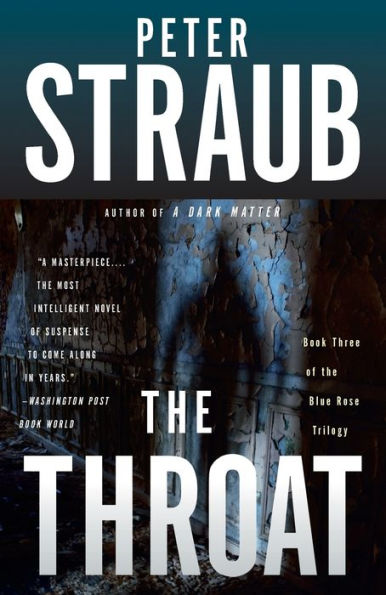The Throat (Blue Rose Trilogy #3)
The #1 New York Times bestselling author of Ghost Story brings the chilling Blue Rose Trilogy to an astonishing close—secrets unearthed, demons revisited, and mysteries solved. • “A masterpiece…. The most intelligent novel of suspense to come along in years.” —The Washington Post Book World
Tim Underhill, now an acclaimed novelist, travels back to his hometown of Millhaven, Illinois after he gets a call from John Ransom, an old army buddy. Ransom believes there’s a copycat killer on the loose, mimicking the Blue Rose murders from decades earlier—he thinks his wife could be a potential victim. Underhill seeks out his old friend Tom Pasmore, an aging hermit who has attained minor celebrity as an expert sleuth, to help him investigate. They quickly discover that Millhaven is a town plagued by horrifying secrets and there is a twisted killer on the loose who is far more dangerous than they ever imagined. Expertly tying together the events of Koko and Mystery, The Throat proves Peter Straub to be the master of the suspense novel.
1100320619
Tim Underhill, now an acclaimed novelist, travels back to his hometown of Millhaven, Illinois after he gets a call from John Ransom, an old army buddy. Ransom believes there’s a copycat killer on the loose, mimicking the Blue Rose murders from decades earlier—he thinks his wife could be a potential victim. Underhill seeks out his old friend Tom Pasmore, an aging hermit who has attained minor celebrity as an expert sleuth, to help him investigate. They quickly discover that Millhaven is a town plagued by horrifying secrets and there is a twisted killer on the loose who is far more dangerous than they ever imagined. Expertly tying together the events of Koko and Mystery, The Throat proves Peter Straub to be the master of the suspense novel.
The Throat (Blue Rose Trilogy #3)
The #1 New York Times bestselling author of Ghost Story brings the chilling Blue Rose Trilogy to an astonishing close—secrets unearthed, demons revisited, and mysteries solved. • “A masterpiece…. The most intelligent novel of suspense to come along in years.” —The Washington Post Book World
Tim Underhill, now an acclaimed novelist, travels back to his hometown of Millhaven, Illinois after he gets a call from John Ransom, an old army buddy. Ransom believes there’s a copycat killer on the loose, mimicking the Blue Rose murders from decades earlier—he thinks his wife could be a potential victim. Underhill seeks out his old friend Tom Pasmore, an aging hermit who has attained minor celebrity as an expert sleuth, to help him investigate. They quickly discover that Millhaven is a town plagued by horrifying secrets and there is a twisted killer on the loose who is far more dangerous than they ever imagined. Expertly tying together the events of Koko and Mystery, The Throat proves Peter Straub to be the master of the suspense novel.
Tim Underhill, now an acclaimed novelist, travels back to his hometown of Millhaven, Illinois after he gets a call from John Ransom, an old army buddy. Ransom believes there’s a copycat killer on the loose, mimicking the Blue Rose murders from decades earlier—he thinks his wife could be a potential victim. Underhill seeks out his old friend Tom Pasmore, an aging hermit who has attained minor celebrity as an expert sleuth, to help him investigate. They quickly discover that Millhaven is a town plagued by horrifying secrets and there is a twisted killer on the loose who is far more dangerous than they ever imagined. Expertly tying together the events of Koko and Mystery, The Throat proves Peter Straub to be the master of the suspense novel.
21.0
In Stock
5
1

The Throat (Blue Rose Trilogy #3)
704
The Throat (Blue Rose Trilogy #3)
704Paperback
(Not eligible for purchase using B&N Audiobooks Subscription credits)
$21.00
21.0
In Stock

Product Details
| ISBN-13: | 9780307472236 |
|---|---|
| Publisher: | Knopf Doubleday Publishing Group |
| Publication date: | 08/10/2010 |
| Series: | Blue Rose Trilogy , #3 |
| Pages: | 704 |
| Product dimensions: | 5.20(w) x 7.90(h) x 1.50(d) |
About the Author
From the B&N Reads Blog
